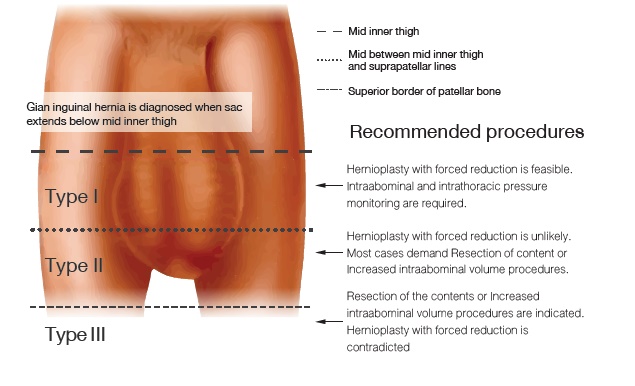Classification System for Giant Inguinal Hernia by Siriraj
Inguinal hernia is a common disease in general medical practice. It can occur in both males and females and requires surgical treatment. Annually, a large number of patients undergo hernia repair surgery at Siriraj Hospital. However, giant inguinal hernia is much rarer due to its definition: a hernia extending below the midpoint of the inner thigh when the patient is standing. This condition results from patients leaving the hernia untreated for a long time. Nowadays, with improved and accessible healthcare services, patients receive treatment earlier, making this condition less common.
Giant inguinal hernia is found exclusively in males and is significantly more complex and difficult to treat compared to regular inguinal hernias. The complication rate is high, with literature reviews indicating a 40% complication rate in patients undergoing surgery for giant inguinal hernia. Historically, there have been reports of deaths due to the sudden and significant increase in intra-abdominal pressure when returning the herniated organs, which had been outside the abdominal cavity for a long time, back into the cavity, leading to respiratory failure.
Due to the rarity and complexity of giant inguinal hernia, most medical reports are case reports, lacking a classification system or standardized surgical recommendations. In 2014, Assoc. Prof. Atthaphorn Trankarnsanga, M.D., FRCST., and colleagues from the Minimally Invasive Surgery Unit, Department of Surgery, Faculty of Medicine Siriraj Hospital, Mahidol University, developed a classification system for giant inguinal hernia. This system divides the disease into three types based on the size of the hernia sac and proposes corresponding treatment methods. The system was published in an international medical journal and has been cited in over 60 medical journals and international conference lectures.

In 2024, the authors conducted a literature review and meta-analysis to verify the accuracy of this classification system. They found that for type I giant inguinal hernia, all 66 reported cases were successfully treated according to the recommended guidelines. For types II and III, among 33 cases, eight patients did not receive treatment according to the classification recommendations, resulting in severe complications in 36% of these cases, including abdominal compartment syndrome and pulmonary embolism. However, there were no reported deaths, demonstrating the accuracy of the classification system developed by Siriraj.
This achievement is a source of pride for Siriraj, reflecting its longstanding commitment to academic research that benefits patient care, both in Thailand and internationally. This aligns with Siriraj’s 2024 concept of “we are ready” and exemplifies the “ready to discover” initiative.



